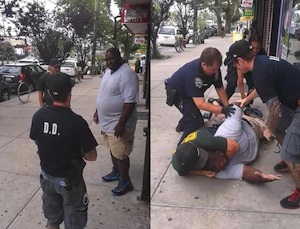Coast to Coast Explosion of Protest Confronts Police Violence in Communities of Color
Posted Dec. 10, 2014
![]() Interview with Glen Ford, executive editor with the Black Agenda Report, conducted by Scott Harris
Interview with Glen Ford, executive editor with the Black Agenda Report, conducted by Scott Harris

Ten days after protests erupted across the country in response to a Missouri grand jury decision not to indict Ferguson police officer Darren Wilson in the shooting death of unarmed African American teenager Michael Brown, another grand jury decision in New York City further provoked dissent. A Staten Island grand jury decided not to indict police officer Daniel Pantaleo, who used an illegal choke-hold that killed Eric Garner, an unarmed 53-year-old black man. This, despite a cell phone video that captured the entire July 17th incident that began when police officers attempted to arrest Garner for allegedly selling loose cigarettes on a sidewalk.
Reacting to the grand jury decision in the Eric Garner case, protests exploded from coast-to-coast, where angry demonstrators condemned a broken judicial system that appeared once again to ignore stark evidence of unprovoked police violence in black communities. Many protest organizers and demonstrators link the disproportionate number of police shootings in minority neighborhoods to the drug war, where blacks and Latinos suffer more frequent arrests and harsher prison sentences than their white counterparts. According to a 2009 report by the Sentencing Project, African-Americans make up 12 percent of the nation’s drug users, but represent 34 percent of those arrested for drug offenses, and 45 percent of those in state prison for such offenses, as of 2005.
Between The Lines’ Scott Harris spoke with Glen Ford, executive editor with the Black Agenda Report who discusses why he believes recent cases of police brutality have reached a tipping point and mobilized unexpected levels of dissent nationwide. He also examines the momentum now present to build a national movement that can effectively challenge a system that fails to recognize and address the root causes of police violence in communities of color across the U.S.
For more information on the Black Agenda Report, visit blackagendareport.com.
Related Links:
 Interview with Glen Ford, conducted by Scott Harris, Counterpoint, Dec. 8, 2014 (22:32)
Interview with Glen Ford, conducted by Scott Harris, Counterpoint, Dec. 8, 2014 (22:32)- “The New Movement: Are We There Yet?” Black Agenda Report, Dec. 3, 2014
- Hands Up United at handsupunited.org
- Millennial Activists United at Tumbler millennialau.tumblr.com
- Millennial Activists United at Tumbler twitter.com/MillennialAU
- Ferguson Action fergusonaction.com/demands
- Ferguson Action fergusonaction.com/white-house-meeting
- “Grand Jury Doesn’t Indict Staten Island Cop in Death of Eric Garner,” Mother Jones, December 2012
- “Wave of Protests After Grand Jury Doesn’t Indict Officer in Eric Garner Chokehold Case,” New York Times, Dec. 3, 2014
- “Blacks Less Likely To Sell Drugs, Much More Likely To Be Arrested For It, Study Says,” Huffington Post, Oct. 1, 2014
- “Criminal injustice: The percentage of African-Americans in prison,” MSNBC, Sept. 23, 2013
- “The Changing Racial Dynamics of the War on Drugs,” SentencingProject.org, April 2009
President Obama Reverses Course on Ending America’s Longest War in Afghanistan
Posted Dec. 10, 2014
 Interview with Matthew Hoh, senior fellow at the Center for International Policy, conducted by Scott Harris
Interview with Matthew Hoh, senior fellow at the Center for International Policy, conducted by Scott Harris On Dec. 8, Western military commanders gathered in Afghanistan’s capital Kabul to symbolically lower the flag, closing the joint U.S. and NATO headquarters for the International Security Assistance Force, signaling the coming end to the coalition’s combat role in the wartorn country. According to U.S. General John Campbell, commander of the ISAF, coalition forces will soon be downsized to a force of about 3,000 soldiers to train and support Afghan troops.
On Dec. 8, Western military commanders gathered in Afghanistan’s capital Kabul to symbolically lower the flag, closing the joint U.S. and NATO headquarters for the International Security Assistance Force, signaling the coming end to the coalition’s combat role in the wartorn country. According to U.S. General John Campbell, commander of the ISAF, coalition forces will soon be downsized to a force of about 3,000 soldiers to train and support Afghan troops.While the ceremony in Kabul was in sync with President Obama’s May 27 pledge to end U.S. combat operations in Afghanistan by the end of 2014, according the New York Times, the president signed a secret order in November that laid out a very different scenario. That order authorizes the U.S. military to carry out missions against the Taliban and other militant groups that are deemed a threat to American troops or the Afghan government. The reports says that the new authorization also allows “American jets, bombers and drones to support Afghan troops on combat missions.”
Outgoing U.S. Defense Secretary Chuck Hagel announced on Dec. 6 that up to 1,000 more U.S. soldiers will remain in Afghanistan than originally outlined, totaling an estimated 10,800 into next year. An agreement signed in September by Washington and newly-elected Afghan president Ashraf Ghani authorizes American forces to be deployed in Afghanistan for at least another 10 years.
Between The Lines’ Scott Harris spoke with Matthew Hoh, senior fellow at the Center for International Policy, a former Marine captain who in 2009 resigned his State Department post in protest of American policy in Afghanistan. Here, he takes a critical look at President Obama’s recently revised strategy in the Afghan conflict, America’s longest war. For more information on the Center for International Policy, visit ciponline.org/.
Related Links:
 Interview with Matthew Hoh, conducted by Scott Harris, Counterpoint, Dec. 8, 2014 (24:53)
Interview with Matthew Hoh, conducted by Scott Harris, Counterpoint, Dec. 8, 2014 (24:53)
Anti-Drone Peace Activist Avoids Jail Time for Protest, Asks that Focus Remains on Drone Victims
Posted Dec. 10, 2014
 Interview with Mark Colville, longtime peace activist, conducted by Melinda Tuhus
Interview with Mark Colville, longtime peace activist, conducted by Melinda Tuhus Longtime peace activist Mark Colville was convicted in September of five misdemeanor charges related to his December 2013 protest against drone warfare conducted by the 174th Attack Wing of the Air National Guard at Hancock Air Force base in upstate New York. At his sentencing hearing on Dec. 3 in Syracuse, New York, Judge Robert Jokl told Colville in a pre-trial conference that if he declined to accept the plea bargain offered and was convicted in court, he, the judge, would sentence him to the maximum, of just over two years in prison.
Longtime peace activist Mark Colville was convicted in September of five misdemeanor charges related to his December 2013 protest against drone warfare conducted by the 174th Attack Wing of the Air National Guard at Hancock Air Force base in upstate New York. At his sentencing hearing on Dec. 3 in Syracuse, New York, Judge Robert Jokl told Colville in a pre-trial conference that if he declined to accept the plea bargain offered and was convicted in court, he, the judge, would sentence him to the maximum, of just over two years in prison.Colville, who with his wife Luz runs the Amistad Catholic Worker house of hospitality in New Haven, Connecticut, is the father of four children. He has been arrested for peace actions many times over the years. In this case, the judge decided not to sentence him to jail time because he said it would “serve no purpose” to do so. Instead, some conditions were attached to his release and the failure to comply with them could send him to jail. Conditions included not being arrested in New York State for a period of one year, payment of a fine of more than $1,000 and providing the court with a DNA sample. Colville was defiant, and said he had no intention of complying with the court-imposed conditions. Several other activists in the anti-drone protest movement in New York state have been sentenced to jail time over the past year.
Between The Lines’ Melinda Tuhus Tuhus spoke with Colville shortly after his conditional release. Here, he explains that his protest took place in the context of a broader movement to end drone warfare, and wants the focus to remain on the victims of U.S. drone attacks.
MARK COLVILLE: As I’ve said outside the courtroom, this is a nice outcome for me, but the drone attacks continue. Just yesterday, four people were slaughtered in a house by a drone strike, so we still have a lot of work to do, particularly at that drone base people are continuing to organize and to try to resist the crimes that are being committed from there.
BETWEEN THE LINES: Do you have any idea what the judge meant when he said it would “serve no purpose” to sentence you to jail or to supervised probation?
MARK COLVILLE: No, it was a little befuddling, because, you know, there have been a steady stream of trials going on in that court, half of them presided over by him, and there’s another judge there as well. The penalties have been getting progressively worse. They just sentenced a 76-year-old former school teacher to three months and then three years of supervised probation, and then a grandmother of three was given a year for a charge under which I was also convicted. In fact, I was convicted on five separate charges for simply peacefully walking to the front gate with a written plea from an Afghani man whose family members were killed in a drone strike. For that I was tried and convicted on five separate charges. What does that mean? I don’t know what it means. It certainly means the judge has been acting a bit erratically.
BETWEEN THE LINES: When protesters are arrested for misdemeanors, they often just pay a fine rather than go to trial and risk jail time. Since you’ve done this several times in the past, you obviously see value in going to court. Can you talk about that?
MARK COLVILLE: Yeah, well, and specifically in this particular case, I mean, this man, Raz Muhammed is his name, he had written a plea to the courts in the U.S., and to the government and military, to stop the drone attacks. In this handwritten letter of his, he explained what had happened to his family, victims of a drone strike, which killed his brother-in-law and several of his friends. And so he was describing that and what life was like for his family now. And again, the basis of his letter was this plea. So we went to the base with the plea. To my mind, I wanted his plea to be heard in court; I wanted his letter to be read in court. There really was no other way to bring it to court, that I could think of anyway. And in fact, I was able to have his letter read in its entirety in open court as I cross-examined one of the military personnel who had taken the stand as a witness against me.
In general, when I do acts of civil resistance, it’s very important to me to go to court, because in so many cases the courts are acting in concert with the government and the military in not only perpetuating these injustices, but legitimizing them. In the case of drones and interventionary way, it has to do with the courts ignoring the law – not only applicable law, but superceding law like Constitutional and international law, which forbid the kinds of attacks the U.S. is perpetrating with drones. And so to me it’s an essential part of the witness and the action – to be in court, to go to court and put the question to the court members and to the judge in particular – to take responsibility of applying the law, in other words, this case is not about somebody trespassing on a military base. It’s not about disorderly conduct or any of those other petty little charges that they want to exclusively focus on – it’s about what’s going on behind the gates of that base.
I mean, one of the charges I was given, one of the more serious ones, is called Obstruction of Governmental Administration. And the way that statute reads, a person is guilty of that if they obstruct the lawful administration of government. Of course, my contention in court was that what the government is doing at that drone base is not lawful. So I tried to take apart that statute and have a fair hearing on whether or not the drone policies and what they’re doing there is legal. And, of course, at most points along the line there, my defense was shut down because they don’t want to engage those questions.
Mark Colville is a member of the Catholic Worker movement and peace activist involved in protest actions against U.S. drone warfare. Learn more about groups opposed to drone warfare by visiting UpstateDroneAction.org .
-
This week’s summary of under-reported news
Compiled by Bob Nixon
- In the midst of escalating violence in Jerusalem, the lower house of the French Parliament overwhelming adopted a non-binding resolution to recognize the Palestinian state. (“Symbolic vote in France backs Palestinian State,” New York Times, Dec. 2 2014; “French vote on Palestinian Statehood takes bumpier route to ‘oui’,” Christian Science Monitor, Dec. 2 2014)
- In early October, former Chicago Police commander Jon Burge walked out of jail after being convicted for lying about the torture of over 100 African-American men in custody over a 20-year period. (“The unhealed wounds of police torture,” In These Times, Oct. 2, 2014)
- On the eve of Labor Day, top anti-union campaigners gathered at the Heritage Foundation to launch a new drive to undermine workers’ rights, by pushing for new so-called “right to work” laws in city and county governments across the U.S. (“Are cities the next front in the Right’s war on labor?” The Nation, Dec. 3, 2014)



